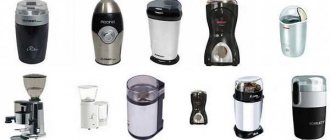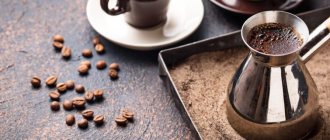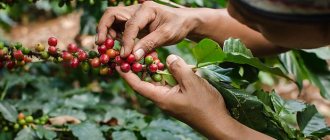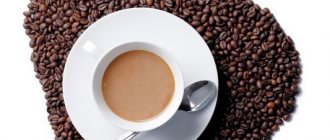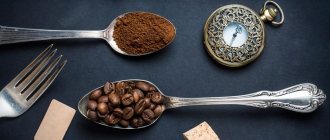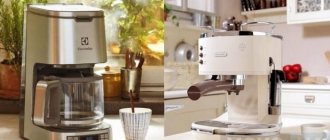Let's talk about which coffee grind is best for a coffee machine. The quality of the drink depends on the size of the fractions. The grains are pre-ground in a coffee grinder or using improvised means. Modern models of coffee machines are equipped with a built-in coffee grinder with low-noise millstones. You can program different degrees of grinding and brew the perfect aromatic coffee. But the wrong choice of grind will affect the taste of the coffee and can damage the machine.
Types of coffee grinding
First, let’s talk about what the degree of grinding of beans affects. The taste and aroma of the drink depend on the size of the fractions. If you use a grind that is not suitable for the coffee machine, the coffee will turn out “empty”. Read more about the differences in the article “Types of coffee grinding and what it affects.”
There are 5 grinding levels:
Powder - used exclusively for Turks. The coffee is brewed on the stove for a few minutes, so the factions have time to fully develop their aroma. The drink turns out thick and very strong.
For espresso – suitable for coffee machines in which the drink is prepared by steam passing through ground coffee beans.
Small (thin) – also suitable for Turks.
Medium is the most common. It is most often used when brewing a drink in a coffee machine.
Large (coarse) – fraction size up to 1 mm. The particles are retained in the filter, so the deep notes of the drink can be revealed. Suitable for French press and drip coffee maker.
Adjusting the grinding degree
It is believed that the ideal espresso will be obtained if the extraction time for one portion of bean is about 25 seconds. If the time is less than 22 seconds, the grind will be too coarse, and if more than 28, the grind will be too fine.
Most modern coffee machines are equipped with a built-in coffee grinder, which makes grinding the beans somewhat easier. In order to achieve the ideal extraction for a coffee machine, you should adjust the coffee grinding using a dial control, which has corresponding divisions, often with a graphic designation. Typically, the cost of one division is 2 seconds of the grinding process.
The degree of grinding of coffee beans is a very important characteristic that should be taken quite seriously. Only an inexperienced coffee lover might think that this is an insignificant detail that does not affect the taste characteristics. The difference in grinding coffee, especially when grinding it for a coffee machine, is quite significant and, if you do everything correctly, you can enjoy a drink whose delights are described in fiction books and commercials.
Grinding devices
Manual coffee grinder
Coffee grinders are manual and automatic. The difference between the two is that the manual device is activated by a handle. It is rotated clockwise and the millstones are activated.
The advantage of such coffee grinders is their low cost and autonomous operation. You don't have to look for an outlet or buy batteries.
The disadvantage is that you cannot choose the degree of grinding and obtain powder fractions. Only a medium grind is obtained.
It will not be possible to achieve perfectly ground beans. Some of them will not be completely crushed.
Another disadvantage is that you will have to make an effort to manually grind a large number of grains.
Interesting! What is mocha coffee and how to make it?
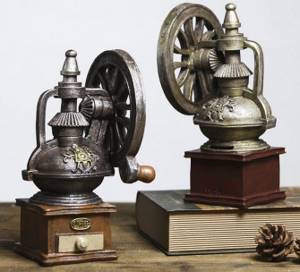
Electrical device
This coffee grinder is often equipped with an additional function - you can select the degree of grinding using the switch lever.
Also among the advantages is that the unit works independently and ideally grinds grains.
The downside is that it works on the network and the high price.
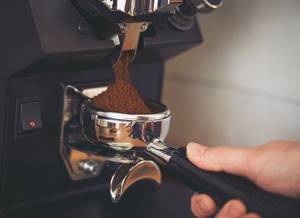
Coffee grinding
True connoisseurs of the aromatic drink know firsthand that its taste largely depends on several components, and the most important factor is coffee grinding.
To decide what the grind will be, it is important to determine the type of coffee. High-quality grains will make a magnificent drink that will not only invigorate you, but also inspire you to new achievements. The degrees of grinding can be very different and it doesn’t matter whether it is coarsely ground or finely ground into powder, the quality of the drink will not change significantly. Each degree of grinding serves specific purposes, and only by studying all levels of grinding degree can one understand how interesting this or that degree is to a lover of an aromatic drink. Each type of grain has its own characteristics, and in order for everything to work out at a sufficiently high level, it is important to be able to determine the type of grain.
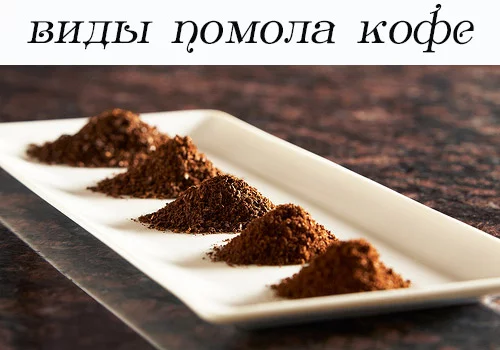
Many people wonder what influences the degree of grinding of coffee. And it is not surprising that grinding is an important component of an aromatic drink. Before coffee is ground, its beans must be roasted, and the degree of grinding also largely affects the taste of the drink. The main secret of delicious coffee is quality beans. This particular drink has excellent taste characteristics. It is equally important to grind the beans immediately before preparing the drink to obtain the ideal drink. When storing ground grains, it is necessary to follow certain rules for sealing the packaging. It is advisable to store them in a glass jar with a tightly closed lid. Foil bags are also suitable, the free end of which must be folded in several layers and secured with a stationery clip or clothespin. If they are stored incorrectly, the aroma and taste of the drink will be of very poor quality, the drink will lose all its flavor and beneficial properties. Such a drink will be unsuitable for consumption and will only disappoint those for whom it was prepared. Degrees of grinding of grains to create a magical drink Degrees of grinding of grains consist of five steps and these stages are defined by such types as: - coarse grinding; - medium grind; - fine grinding; - espresso; - powdery.
How to grind coffee without a coffee grinder
You can grind the grains using a blender or food processor. Measure out the required amount of raw material and pour it into the unit. Cover with a lid and turn on medium speed. The process will take about 30 seconds.
An immersion blender will do. Place the beans in a narrow, high-sided container and insert the blender. After 30-40 minutes, the grains will be crushed to medium-sized fractions.
A rolling pin works well. Place the beans on a board, cover with a bag and grind with a rolling pin until the desired degree of grinding is achieved.
Also suitable:
- hammer;
- knife;
- mechanical meat grinder;
- a blunt, heavy object.
For instructions on the above methods, see the article “How to Grind Coffee Without a Coffee Grinder.”
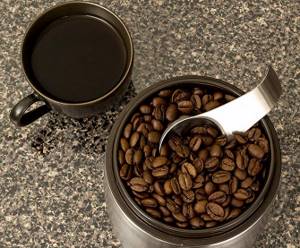
Built-in coffee grinder
Advantages and disadvantages
The optimal solution is a coffee machine with a built-in coffee grinder. This feature increases the cost of the unit by 20%. But you can get perfectly crushed grains with the press of one button.
In a semi-automatic unit, we set the required grinding ourselves. With an automatic device, no adjustment is required.
The only drawback is that it is impossible to remove the coffee grinder reservoir and wash it. You will have to run a complete cleaning of the coffee machine.
Units of the De'Longhi (Delonghi), Merol, Bosch, Saeco brands are common. These manufacturers produce models for home use and professional coffee machines.
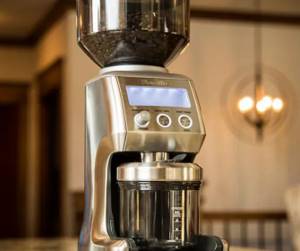
How do the models differ?
Now about the difference between devices of three price categories.
The cost of a budget coffee machine with a built-in coffee grinder starts from 55 thousand rubles. It is equipped with metal millstones. The power is sufficient for preparing an invigorating drink at home.
In such devices you will have to independently set the degree of grinding. Typically there are models with two grinding options - coarse and fine.
Units from 80 to 100 thousand rubles come with metal and ceramic millstones. The degree of grinding is also selected manually. But there is more choice of cars in this category.
Devices costing more than 100 thousand rubles include a coffee grinder with ceramic millstones. They are quieter than metal ones and do not overheat during operation.
Coffee grind level
The degree of grinding of coffee is divided into five main stages. The type of grinding in this case is determined by the size of the resulting particles, very small, reminiscent of flour, or larger.
Rough (large)
The particles of crushed grains in this case can reach one millimeter in size. They are ideal for brewing coffee, that is, preparing it, for example, in a French press. Firstly, such particles are most easily retained in such a device, and, secondly, they are the ones who most fully reveal their properties when poured with hot water. In addition, this size is perfect for a drip coffee maker or coffee pot.
Average
This is a universal coffee grinder for a coffee machine. Typically, standard devices work with exactly this size, which gives an excellent taste, and at the same time is easily retained by filters. This is also the ideal grind for a carob coffee maker. In addition, it can be used in the same way as in the case of large particles, since the capabilities of both options are not very different.
Small (thin)
The fine grinding options are more limited than the other two. It is ideal for brewing a drink in a cezve (or, as it is also called, a Turk).
For espresso
This is an ultra-fine option, the finest grind, suitable only for special coffee machines in which espresso is prepared by passing hot steam through crushed beans.
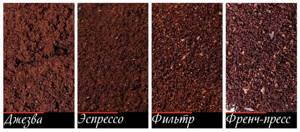
Each type of coffee needs its own grind
Powdery
Another ultra-fine grind - powder - is considered the best for preparing real Turkish coffee or an oriental drink, which is why it is sometimes called “classic Turkish grind”. Due to the settling “slurry”, such coffee seems thicker and somewhat stretchy, which is why it is perceived completely differently.
You might be interested in Equipment for making coffee on sand at home
In addition, medium-fine grind coffee for a coffee machine is sometimes distinguished, located between two degrees of grinding, as the name suggests. This cannot be said to be a universal solution, but it can be used instead of one or the other option if necessary.
Video on the topic
How grind degree affects the taste of espresso
Click Play to view
Selecting the grinding degree
Consider the type of coffee machine
Choose a grind depending on your coffee machine. The manufacturer provides information in the instructions.
Interesting! Coffee latte - composition and recipes for making it at home, history of origin
Manufacturers of professional coffee machines recommend using coffee of the same brand.
Brew a test cup. If the drink is watery or very bitter, the degree of grinding is not suitable.
Special espresso blends are produced. They are suitable for all models of coffee makers and are already ground.
The coffee machine cannot be used to brew coffee from ground flavored beans. They contain a large amount of oils that will damage the unit. The article “Which coffee beans is best to choose for a coffee machine” is described in detail.
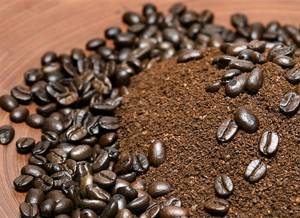
Grinding degree
In semi-automatic units, the drink is brewed from medium-ground beans. Fine fractions are not used in all brands. They are suitable for models in which steam under pressure passes through the ground grains.
Powdered coffee grinding is not suitable for a coffee machine. Small particles will clog the filter. At best, the drink will cook slowly. At worst, the device will fail.
Large particles will not have time to impart aromatic and taste properties to the water. The drink will be watery.
Automatic devices independently set the degree of grinding depending on the type of drink, temperature and pressure.
The choice of grinding degree depends on the microclimate. Consider humidity and temperature.
If the humidity is above 85%, the coffee beans become slightly larger. The crushed particles become compacted, and the coffee acquires a bitter taste.
At warm temperatures and average humidity, the grains may not have time to impart their flavor to the water. Therefore, they are first compacted in a holder.
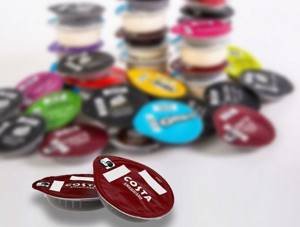
Tassimo wheels
Capsule-type coffee machines brew coffee from T-discs.
Place the capsule in the coffee machine compartment (location depends on the model) and turn on the device.
The device reads the barcode from the disk and sets the parameters for making cappuccino or latte. The needle will then pierce the capsule and a stream of water will flow through the pressed coffee.
The advantage is that there is no need to select the degree of grinding.
Information about the existence of reusable T-disks is erroneous. Such a product is not produced today.
Unscrupulous companies sell supposedly reusable capsules. But they will only ruin the coffee machine.
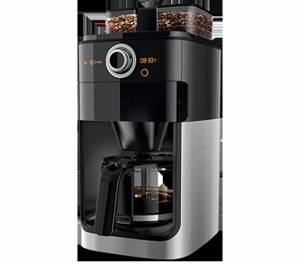
How to adjust the grind
Depending on the model of the device, the degree of grinding can be set with a button on the panel or with a dial-regulator.
The numbers on the regulator are: 1 – fine grinding, 3 – medium, 5 – coarse. The number of digits depends on the model.
The smaller the distance between the millstones, the larger the fractions will be. The first time you try, you may not be able to adjust the desired degree of coffee grinding. Experiment and brew a few cups.
Interesting! What is Robusta and how is it different from Arabica?
The size of the fractions affects the taste of coffee. Coarse grinding produces a drink with a sour taste. From small - with bitterness.
Coffee extraction takes no more than 25 seconds. If less, the grind is too coarse. More - small.
In a unit with a coffee grinder, the beans are crushed to large fractions in about 9 seconds. It takes 15 seconds to get a medium grind. Small – 20 seconds.
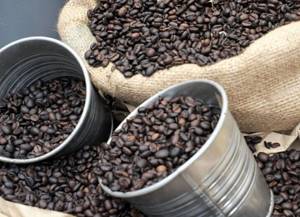
How to choose grinding degree?
Choose the required degree of grinding depending on how and in what container you plan to prepare coffee.
Grinding coffee for French press
In a French press, coffee releases its flavor and aromatic substances by infusing it in gradually cooling water. A French press requires very coarse grinding of grains, with a particle size of approximately 0.8-1 mm in diameter. You can determine it tactilely - to the touch such grinding is similar to grains of pickling, coarse-grained salt. The optimal time for extraction is 4 minutes.
For a French press, you can use coarsely ground coffee, which feels a little coarser than regular salt or cane sugar. You need to insist on grinding this way for less than 3 minutes.
Grinding for brewing coffee in a cup
Coarsely ground coffee is suitable for brewing in a cup. It is better to brew it not with boiling water, but with very hot water at a temperature of 90-92 degrees. Leave for 4 minutes.
Alternative brewing methods - siphon, Chemex, pour-over
Their popularity breaks all records, and this is completely justified. In such devices, coffee produces a rich taste and aroma, of course, if you choose the right grind. For most alternative methods, coarse and medium-ground coffee is suitable, which tactilely resembles regular table salt.
Experts advise paying attention to the size of the device in which you are going to prepare the drink. For a small pour over for one cup, it is better to grind the beans finer, closer to universal. For a Chemex, on the contrary, it makes sense to use coarsely ground coffee, since the Chemex filters are dense and water flows through them slowly.
Grinding coffee for geyser and drip coffee makers
Universal grinding is suitable for them. It looks like fine sugar or river sand, and may contain slightly larger particles. This grind is perfect for drip, geyser and most carob coffee makers. If you grind finer, the extraction will be excessive and the drink will become excessively bitter.
Grinding coffee for a coffee machine
For an automatic coffee maker, a special fine grind is usually used. It is sometimes called an espresso grind. It is distinguished by its small particle size, which should feel like fine “Extra” salt to the touch. The coffee machine requires not only fine, but also homogeneous, without the inclusion of large fractions due to the very short brewing time.
Grinding for Turks (cezves)
For brewing in a Turk, fine, almost powder grinding is required. It is also called powdery or ultra-fine. Small particles that feel like powder are great for making coffee in a Turkish coffee pot, as extraction goes quickly in it. If the grind is coarser, the coffee will turn out watery and sour.
Preparing coffee beans for grinding
Before grinding, the grains are dried and roasted. Unroasted green beans are not used to prepare the drink. Read more in the article “How to roast coffee beans at home.”
It is better to grind the beans directly after roasting and immediately brew coffee from them.
Undried grains are dried in the oven over low heat. Wet beans will not produce a perfect grind.
The more time passes after heat treatment, the less tasty and aromatic the drink turns out. Ground grains lose their aromatic notes after 2-3 hours when stored open.
Place the ground coffee in a dark jar with a lid and use within 14 days.
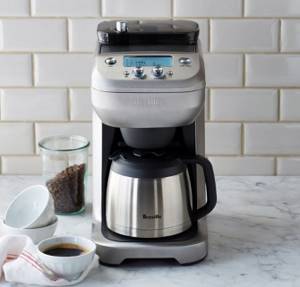
By grinding degree
What grinding affects, first, is the strength of the drink. This indicator also determines in which devices this or that coffee powder can be used.
- A coarse grind is suitable for French press and black roast beans.
- Household machines usually provide medium and fine grinding - it is ideal for making espresso.
- The smallest powder is boiled in a Turk.
The rule applies: the finer the grind, the richer, stronger and more bitter the coffee will be, and its consumption will also be reduced.

The type of grinding to choose is indicated in the technical annotation. These instructions should not be ignored, since improper grinding can not only spoil the drink, but also damage the machine. For example, very small particles can clog the parts of the brewing mechanism and the finished liquid will be difficult to pour out at the outlet.
